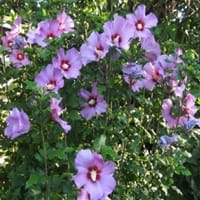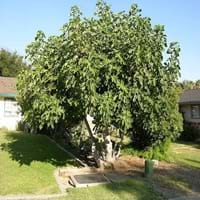Life Span
Perennial
Perennial
Origin
Australia
Mediterranean, Western Asia
Types
Not available
Brown Turkey Fig, Texas Everbearing Fig, Celeste Fig
Habitat
subtropical regions, Temperate Regions, Tropical regions, Warmer regions
Sunny Edge, Woodland Garden
USDA Hardiness Zone
9-11
6-10
Sunset Zone
H1, H2, 13, 14, 15, 16, 17, 20, 21, 22, 23, 24
H1, H2, 4, 5, 6, 7, 8, 9, 12, 13, 14, 15, 16, 17, 18, 19, 20, 21, 22, 23, 24
Habit
Upright/Erect
Oval or Rounded
Flower Color
Blue, Purple, Blue Violet
Green
Flower Color Modifier
Not Available
Bicolor
Fruit Color
Not Available
Purple, Black
Leaf Color in Spring
Dark Green
Green, Dark Green
Leaf Color in Summer
Dark Green
Green, Dark Green
Leaf Color in Fall
Dark Green
Green, Dark Green
Leaf Color in Winter
Dark Green
Light Green
Leaf Shape
Irregular
Irregular
Plant Season
Spring, Summer, Fall, Winter
Spring, Summer, Fall
Sunlight
Full Sun
Full Sun, Partial Sun, Partial shade
Type of Soil
Clay, Loam, Sand
Clay, Loam, Sand
The pH of Soil
Acidic, Neutral, Alkaline
Acidic, Neutral
Soil Drainage
Well drained
Well drained
Bloom Time
Indeterminate
Spring, Early Summer
Tolerances
Not Available
Drought
Where to Plant?
Ground, Pot
Container, Ground
How to Plant?
Seedlings, Semi-hardwood cuttings
Cuttings, Seedlings
Plant Maintenance
Medium
Medium
Watering Requirements
Average Water Needs, Do Not over Water, Requires regular watering
Average Water Needs, Do Not over Water, Needs watering once a week, Requires watering in the growing season
In Summer
Lots of watering
Lots of watering
In Spring
Moderate
Moderate
In Winter
Average Water
Average Water
Soil pH
Acidic, Neutral, Alkaline
Acidic, Neutral
Soil Type
Clay, Loam, Sand
Clay, Loam, Sand
Soil Drainage Capacity
Well drained
Well drained
Sun Exposure
Full Sun
Full Sun, Partial Sun, Partial shade
Pruning
Remove damaged leaves, Remove dead branches, Remove dead leaves
Prune in fall, Remove damaged leaves, Remove dead branches, Remove dead leaves, Remove dead or diseased plant parts
Fertilizers
All-Purpose Liquid Fertilizer
All-Purpose Liquid Fertilizer, fertilize in fall, fertilize in winter
Pests and Diseases
Red blotch, Rust aphids
Red blotch
Plant Tolerance
Not Available
Drought
Flower Petal Number
Single
Not Available
Foliage Texture
Medium
Coarse
Foliage Sheen
Matte
Matte
Attracts
Butterflies, Flying insects, Hummingbirds, Insects
Birds
Allergy
Not Available
Eye irritation
Aesthetic Uses
Borders, Showy Purposes, small hedge
Not Used For Aesthetic Purpose
Beauty Benefits
Not Available
Glowing Skin, Good for skin
Environmental Uses
Air purification
Air purification, Food for birds, Food for insects, Shadow Tree, Windbreak
Medicinal Uses
High blood pressure, lowering blood pressure
anti-cancer, Demulcent, Digestive, Emollient, Galactogogue, Laxative, Pectoral, Stomachic, Tonic
Part of Plant Used
Flowers, Leaves
Fruits, Leaves, Wood
Other Uses
Decoration Purposes
Garland, Used as Ornamental plant, Used for woodware
Used As Indoor Plant
Yes
No
Used As Outdoor Plant
Yes
Yes
Garden Design
Container, Feature Plant, Hedges, Mixed Border, Rock Garden, Wall
Container, Edible, Feature Plant, Fruit / Fruit Tree, Houseplant, Topiary / Bonsai / Espalier
Botanical Name
ALYOGYNE huegelii 'Monle'
FICUS carica 'Black Mission'
Common Name
Blue Hibiscus, Purple Delight Blue Hibiscus
Black Mission Fig, Fig
In Hindi
Blue Hibiscus
Black Mission Fig Tree
In German
Blauer Hibiskus Baum
Schwarz Mission Fig Tree
In French
Bleu Hibiscus Arbre
Noir Mission Fig Tree
In Spanish
Azul árbol del hibisco
Negro Misión de la Higuera
In Greek
Μπλε Hibiscus Tree
Μαύρο Αποστολή Fig Tree
In Portuguese
Árvore azul do hibiscus
Black Tree Fig Missão
In Polish
Niebieski Hibiscus Drzewo
Czarny Mission Fig Tree
In Latin
Hibiscus lignum blue
Niger Mission ficum
Phylum
Magnoliophyta
Magnoliophyta
Class
Magnoliopsida
Not Available
Family
Malvaceae
Moraceae
Clade
Angiosperms, Eudicots, Rosids
Angiosperms, Eudicots, Rosids
Subfamily
Malvoideae
Not Available
Number of Species
Not Available
Not Available
Importance of Blue Hibiscus and Black Mission Fig
Want to have the most appropriate plant for your garden? You might want to know the importance of Blue Hibiscus and Black Mission Fig. Basically, these two plants vary in many aspects. Compare Blue Hibiscus and Black Mission Fig as they differ in many characteristics such as their life, care, benefits, facts, etc. Every gardener must at least have the slightest clue about the plants he wants to plant in his garden. Compare their benefits, which differ in many ways like facts and uses. The medicinal use of Blue Hibiscus is High blood pressure and lowering blood pressure whereas of Black Mission Fig is anti-cancer, Demulcent, Digestive, Emollient, Galactogogue, Laxative, Pectoral, Stomachic and Tonic. Blue Hibiscus has beauty benefits as follows: Not Available while Black Mission Fig has beauty benefits as follows: Not Available.
Compare Facts of Blue Hibiscus vs Black Mission Fig
How to choose the best garden plant for your garden depending upon its facts? Here garden plant comparison will help you to solve this query. Compare the facts of Blue Hibiscus vs Black Mission Fig and know which one to choose. As garden plants have benefits and other uses, allergy is also a major drawback of plants for some people. Allergic reactions of Blue Hibiscus are Not Available whereas of Black Mission Fig have Eye irritation respectively. Having a fruit bearing plant in your garden can be a plus point of your garden. Blue Hibiscus has no showy fruits and Black Mission Fig has no showy fruits. Also Blue Hibiscus is flowering and Black Mission Fig is not flowering . You can compare Blue Hibiscus and Black Mission Fig facts and facts of other plants too.





